Research Proposal: Impact Measurement in Social Cohesion in CAR
VerifiedAdded on 2021/05/31
|16
|3483
|29
Report
AI Summary
This research proposal investigates the impact of social cohesion on sustainable peace in the Central African Republic (CAR). The study explores the concept of social cohesion, its importance, and the current situation in the CAR, highlighting ethno-religious conflicts. The research aims to identify factors influencing social cohesion implementation, analyze the need for it in the CAR, and suggest recommendations for effective implementation. The methodology includes a discussion of research philosophy, design, approach, data sources, ethical considerations, and limitations. The literature review covers the concept of social cohesion, its importance in society, and theoretical aspects, including generative theory and theoretical patterns. The research aims to contribute to understanding the role of social cohesion in conflict resolution and promoting a stable society in the CAR. The study also highlights the significance of social cohesion in fostering effective relationships between communities, improving the quality of life, supporting democracy, and promoting economic growth.
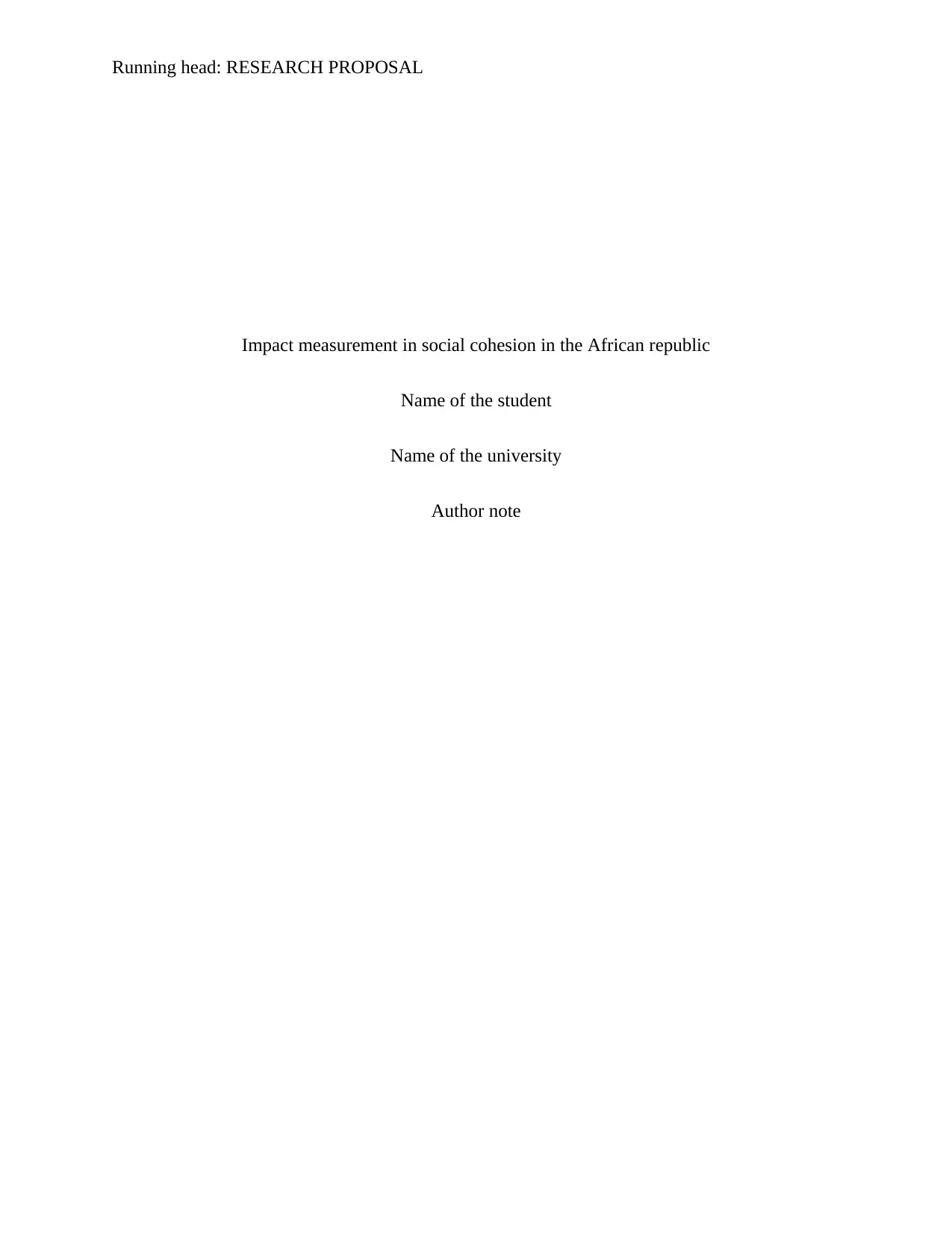
Running head: RESEARCH PROPOSAL
Impact measurement in social cohesion in the African republic
Name of the student
Name of the university
Author note
Impact measurement in social cohesion in the African republic
Name of the student
Name of the university
Author note
Paraphrase This Document
Need a fresh take? Get an instant paraphrase of this document with our AI Paraphraser
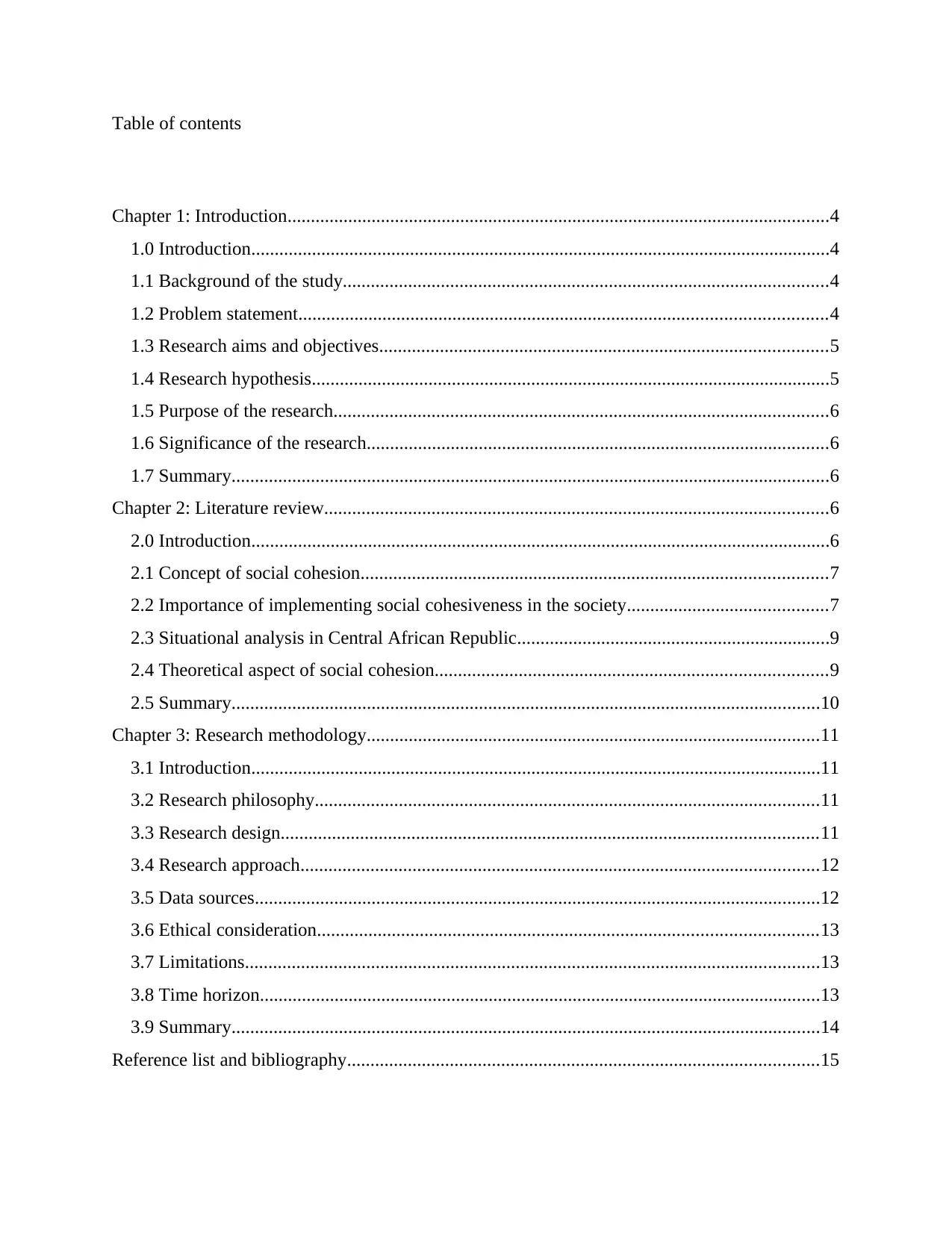
Table of contents
Chapter 1: Introduction....................................................................................................................4
1.0 Introduction............................................................................................................................4
1.1 Background of the study........................................................................................................4
1.2 Problem statement.................................................................................................................4
1.3 Research aims and objectives................................................................................................5
1.4 Research hypothesis...............................................................................................................5
1.5 Purpose of the research..........................................................................................................6
1.6 Significance of the research...................................................................................................6
1.7 Summary................................................................................................................................6
Chapter 2: Literature review............................................................................................................6
2.0 Introduction............................................................................................................................6
2.1 Concept of social cohesion....................................................................................................7
2.2 Importance of implementing social cohesiveness in the society...........................................7
2.3 Situational analysis in Central African Republic...................................................................9
2.4 Theoretical aspect of social cohesion....................................................................................9
2.5 Summary..............................................................................................................................10
Chapter 3: Research methodology.................................................................................................11
3.1 Introduction..........................................................................................................................11
3.2 Research philosophy............................................................................................................11
3.3 Research design...................................................................................................................11
3.4 Research approach...............................................................................................................12
3.5 Data sources.........................................................................................................................12
3.6 Ethical consideration...........................................................................................................13
3.7 Limitations...........................................................................................................................13
3.8 Time horizon........................................................................................................................13
3.9 Summary..............................................................................................................................14
Reference list and bibliography.....................................................................................................15
Chapter 1: Introduction....................................................................................................................4
1.0 Introduction............................................................................................................................4
1.1 Background of the study........................................................................................................4
1.2 Problem statement.................................................................................................................4
1.3 Research aims and objectives................................................................................................5
1.4 Research hypothesis...............................................................................................................5
1.5 Purpose of the research..........................................................................................................6
1.6 Significance of the research...................................................................................................6
1.7 Summary................................................................................................................................6
Chapter 2: Literature review............................................................................................................6
2.0 Introduction............................................................................................................................6
2.1 Concept of social cohesion....................................................................................................7
2.2 Importance of implementing social cohesiveness in the society...........................................7
2.3 Situational analysis in Central African Republic...................................................................9
2.4 Theoretical aspect of social cohesion....................................................................................9
2.5 Summary..............................................................................................................................10
Chapter 3: Research methodology.................................................................................................11
3.1 Introduction..........................................................................................................................11
3.2 Research philosophy............................................................................................................11
3.3 Research design...................................................................................................................11
3.4 Research approach...............................................................................................................12
3.5 Data sources.........................................................................................................................12
3.6 Ethical consideration...........................................................................................................13
3.7 Limitations...........................................................................................................................13
3.8 Time horizon........................................................................................................................13
3.9 Summary..............................................................................................................................14
Reference list and bibliography.....................................................................................................15
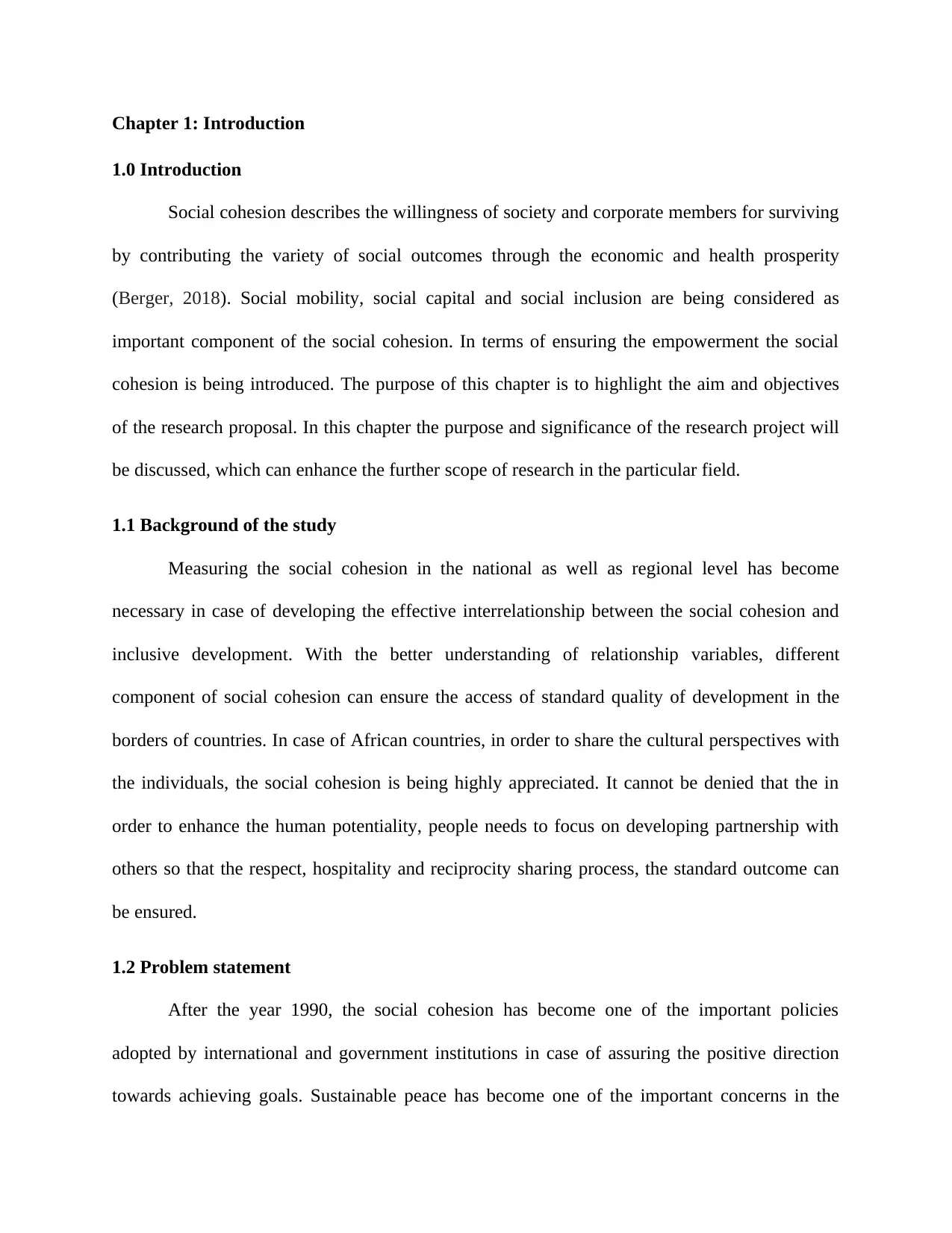
Chapter 1: Introduction
1.0 Introduction
Social cohesion describes the willingness of society and corporate members for surviving
by contributing the variety of social outcomes through the economic and health prosperity
(Berger, 2018). Social mobility, social capital and social inclusion are being considered as
important component of the social cohesion. In terms of ensuring the empowerment the social
cohesion is being introduced. The purpose of this chapter is to highlight the aim and objectives
of the research proposal. In this chapter the purpose and significance of the research project will
be discussed, which can enhance the further scope of research in the particular field.
1.1 Background of the study
Measuring the social cohesion in the national as well as regional level has become
necessary in case of developing the effective interrelationship between the social cohesion and
inclusive development. With the better understanding of relationship variables, different
component of social cohesion can ensure the access of standard quality of development in the
borders of countries. In case of African countries, in order to share the cultural perspectives with
the individuals, the social cohesion is being highly appreciated. It cannot be denied that the in
order to enhance the human potentiality, people needs to focus on developing partnership with
others so that the respect, hospitality and reciprocity sharing process, the standard outcome can
be ensured.
1.2 Problem statement
After the year 1990, the social cohesion has become one of the important policies
adopted by international and government institutions in case of assuring the positive direction
towards achieving goals. Sustainable peace has become one of the important concerns in the
1.0 Introduction
Social cohesion describes the willingness of society and corporate members for surviving
by contributing the variety of social outcomes through the economic and health prosperity
(Berger, 2018). Social mobility, social capital and social inclusion are being considered as
important component of the social cohesion. In terms of ensuring the empowerment the social
cohesion is being introduced. The purpose of this chapter is to highlight the aim and objectives
of the research proposal. In this chapter the purpose and significance of the research project will
be discussed, which can enhance the further scope of research in the particular field.
1.1 Background of the study
Measuring the social cohesion in the national as well as regional level has become
necessary in case of developing the effective interrelationship between the social cohesion and
inclusive development. With the better understanding of relationship variables, different
component of social cohesion can ensure the access of standard quality of development in the
borders of countries. In case of African countries, in order to share the cultural perspectives with
the individuals, the social cohesion is being highly appreciated. It cannot be denied that the in
order to enhance the human potentiality, people needs to focus on developing partnership with
others so that the respect, hospitality and reciprocity sharing process, the standard outcome can
be ensured.
1.2 Problem statement
After the year 1990, the social cohesion has become one of the important policies
adopted by international and government institutions in case of assuring the positive direction
towards achieving goals. Sustainable peace has become one of the important concerns in the
⊘ This is a preview!⊘
Do you want full access?
Subscribe today to unlock all pages.

Trusted by 1+ million students worldwide
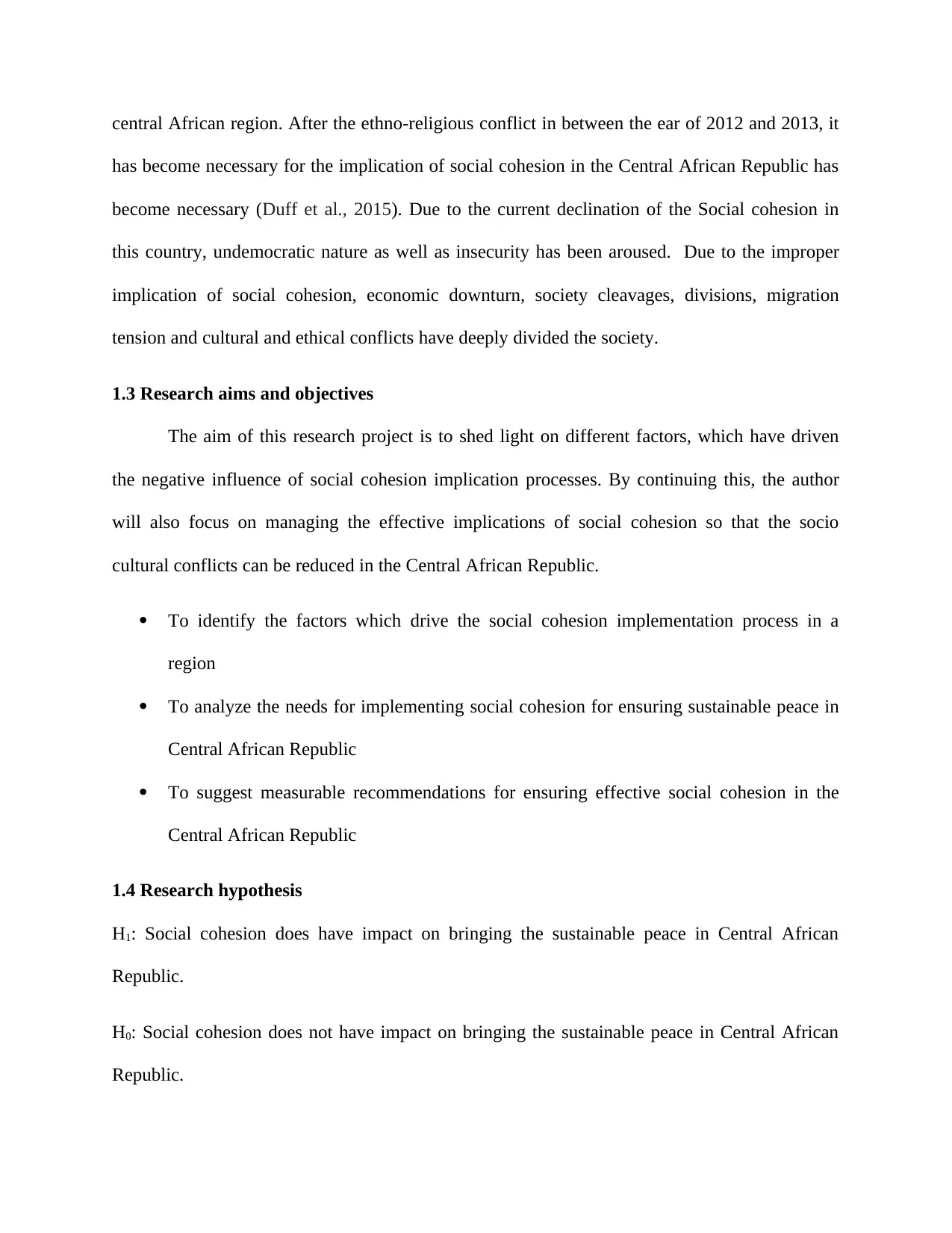
central African region. After the ethno-religious conflict in between the ear of 2012 and 2013, it
has become necessary for the implication of social cohesion in the Central African Republic has
become necessary (Duff et al., 2015). Due to the current declination of the Social cohesion in
this country, undemocratic nature as well as insecurity has been aroused. Due to the improper
implication of social cohesion, economic downturn, society cleavages, divisions, migration
tension and cultural and ethical conflicts have deeply divided the society.
1.3 Research aims and objectives
The aim of this research project is to shed light on different factors, which have driven
the negative influence of social cohesion implication processes. By continuing this, the author
will also focus on managing the effective implications of social cohesion so that the socio
cultural conflicts can be reduced in the Central African Republic.
To identify the factors which drive the social cohesion implementation process in a
region
To analyze the needs for implementing social cohesion for ensuring sustainable peace in
Central African Republic
To suggest measurable recommendations for ensuring effective social cohesion in the
Central African Republic
1.4 Research hypothesis
H1: Social cohesion does have impact on bringing the sustainable peace in Central African
Republic.
H0: Social cohesion does not have impact on bringing the sustainable peace in Central African
Republic.
has become necessary for the implication of social cohesion in the Central African Republic has
become necessary (Duff et al., 2015). Due to the current declination of the Social cohesion in
this country, undemocratic nature as well as insecurity has been aroused. Due to the improper
implication of social cohesion, economic downturn, society cleavages, divisions, migration
tension and cultural and ethical conflicts have deeply divided the society.
1.3 Research aims and objectives
The aim of this research project is to shed light on different factors, which have driven
the negative influence of social cohesion implication processes. By continuing this, the author
will also focus on managing the effective implications of social cohesion so that the socio
cultural conflicts can be reduced in the Central African Republic.
To identify the factors which drive the social cohesion implementation process in a
region
To analyze the needs for implementing social cohesion for ensuring sustainable peace in
Central African Republic
To suggest measurable recommendations for ensuring effective social cohesion in the
Central African Republic
1.4 Research hypothesis
H1: Social cohesion does have impact on bringing the sustainable peace in Central African
Republic.
H0: Social cohesion does not have impact on bringing the sustainable peace in Central African
Republic.
Paraphrase This Document
Need a fresh take? Get an instant paraphrase of this document with our AI Paraphraser
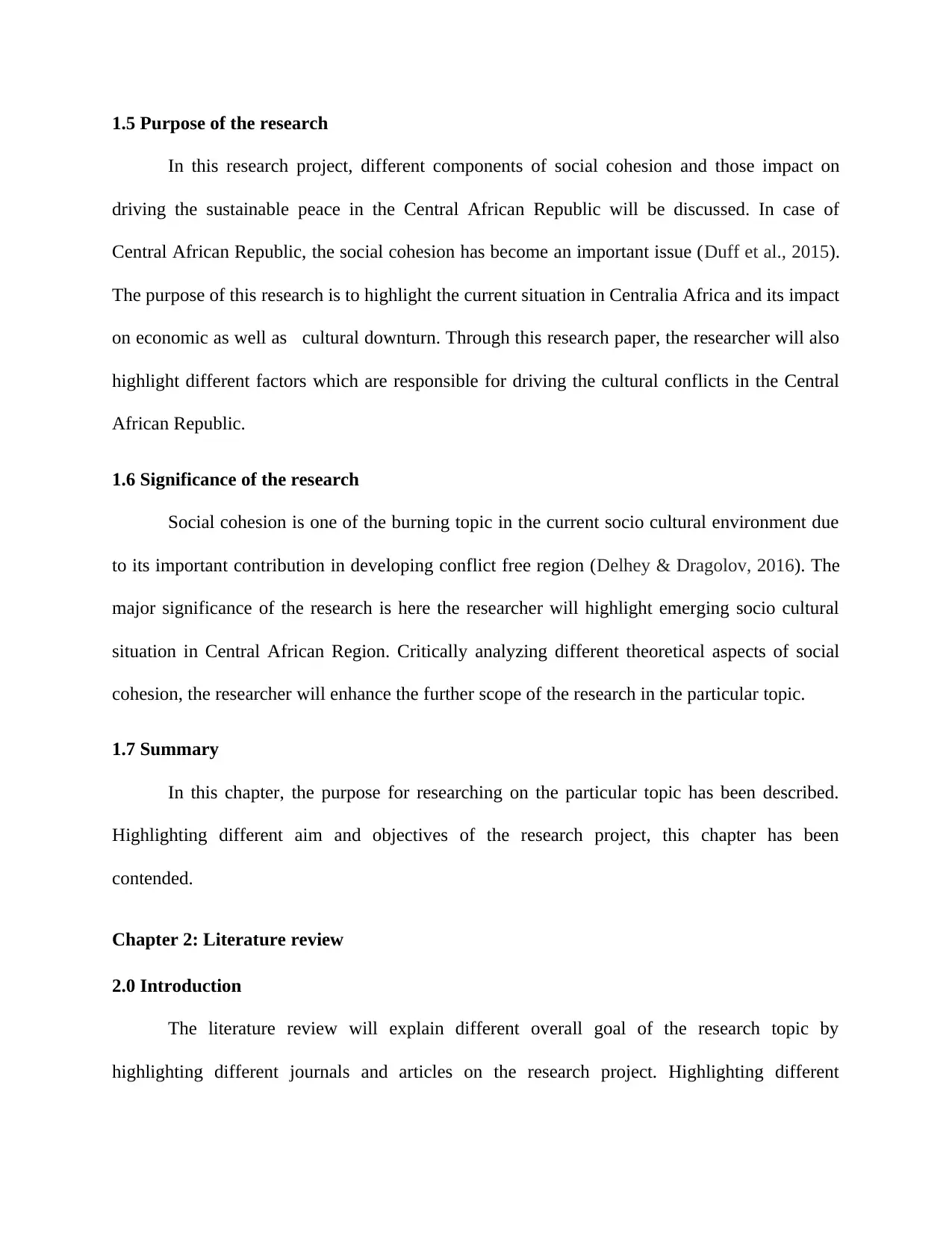
1.5 Purpose of the research
In this research project, different components of social cohesion and those impact on
driving the sustainable peace in the Central African Republic will be discussed. In case of
Central African Republic, the social cohesion has become an important issue (Duff et al., 2015).
The purpose of this research is to highlight the current situation in Centralia Africa and its impact
on economic as well as cultural downturn. Through this research paper, the researcher will also
highlight different factors which are responsible for driving the cultural conflicts in the Central
African Republic.
1.6 Significance of the research
Social cohesion is one of the burning topic in the current socio cultural environment due
to its important contribution in developing conflict free region (Delhey & Dragolov, 2016). The
major significance of the research is here the researcher will highlight emerging socio cultural
situation in Central African Region. Critically analyzing different theoretical aspects of social
cohesion, the researcher will enhance the further scope of the research in the particular topic.
1.7 Summary
In this chapter, the purpose for researching on the particular topic has been described.
Highlighting different aim and objectives of the research project, this chapter has been
contended.
Chapter 2: Literature review
2.0 Introduction
The literature review will explain different overall goal of the research topic by
highlighting different journals and articles on the research project. Highlighting different
In this research project, different components of social cohesion and those impact on
driving the sustainable peace in the Central African Republic will be discussed. In case of
Central African Republic, the social cohesion has become an important issue (Duff et al., 2015).
The purpose of this research is to highlight the current situation in Centralia Africa and its impact
on economic as well as cultural downturn. Through this research paper, the researcher will also
highlight different factors which are responsible for driving the cultural conflicts in the Central
African Republic.
1.6 Significance of the research
Social cohesion is one of the burning topic in the current socio cultural environment due
to its important contribution in developing conflict free region (Delhey & Dragolov, 2016). The
major significance of the research is here the researcher will highlight emerging socio cultural
situation in Central African Region. Critically analyzing different theoretical aspects of social
cohesion, the researcher will enhance the further scope of the research in the particular topic.
1.7 Summary
In this chapter, the purpose for researching on the particular topic has been described.
Highlighting different aim and objectives of the research project, this chapter has been
contended.
Chapter 2: Literature review
2.0 Introduction
The literature review will explain different overall goal of the research topic by
highlighting different journals and articles on the research project. Highlighting different
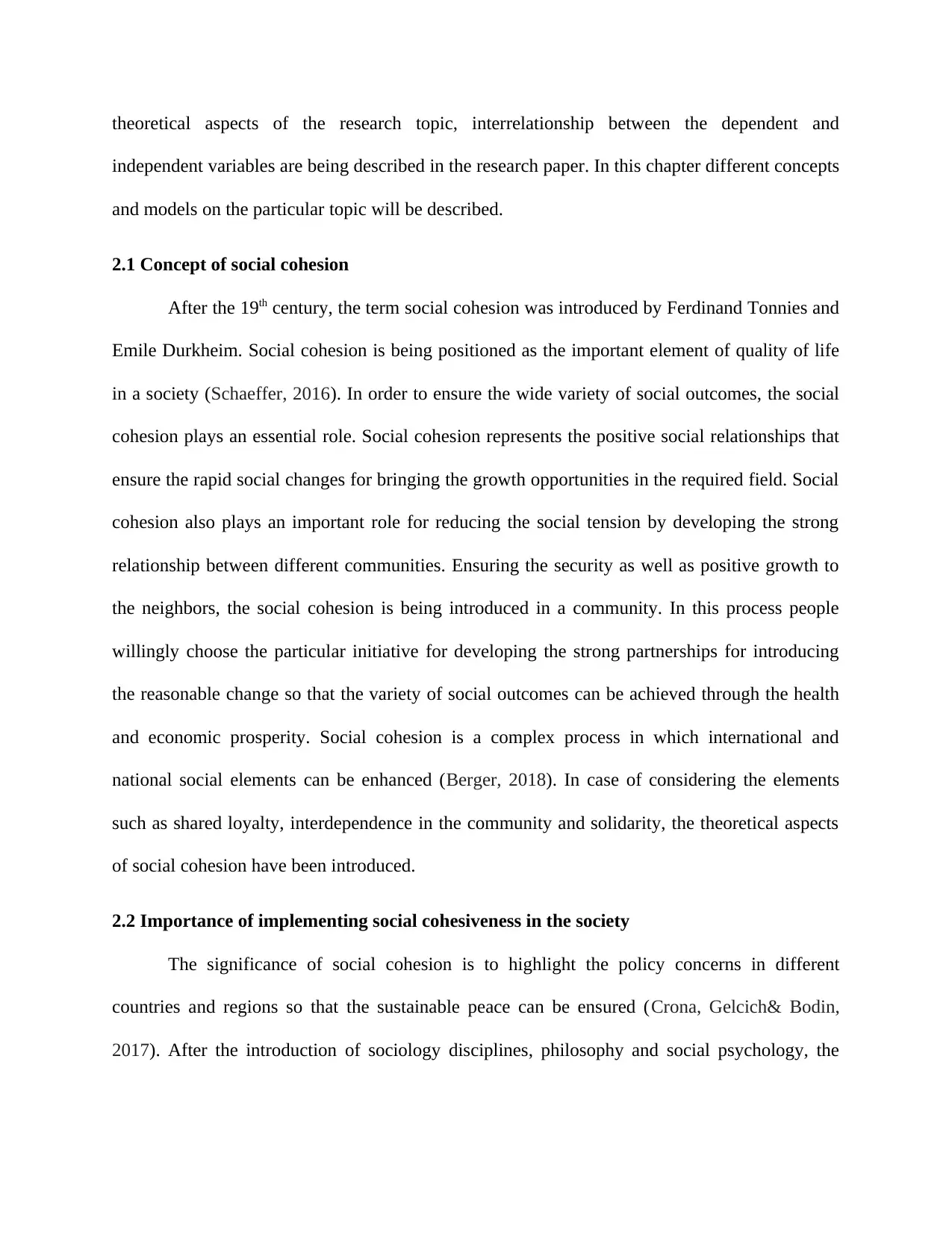
theoretical aspects of the research topic, interrelationship between the dependent and
independent variables are being described in the research paper. In this chapter different concepts
and models on the particular topic will be described.
2.1 Concept of social cohesion
After the 19th century, the term social cohesion was introduced by Ferdinand Tonnies and
Emile Durkheim. Social cohesion is being positioned as the important element of quality of life
in a society (Schaeffer, 2016). In order to ensure the wide variety of social outcomes, the social
cohesion plays an essential role. Social cohesion represents the positive social relationships that
ensure the rapid social changes for bringing the growth opportunities in the required field. Social
cohesion also plays an important role for reducing the social tension by developing the strong
relationship between different communities. Ensuring the security as well as positive growth to
the neighbors, the social cohesion is being introduced in a community. In this process people
willingly choose the particular initiative for developing the strong partnerships for introducing
the reasonable change so that the variety of social outcomes can be achieved through the health
and economic prosperity. Social cohesion is a complex process in which international and
national social elements can be enhanced (Berger, 2018). In case of considering the elements
such as shared loyalty, interdependence in the community and solidarity, the theoretical aspects
of social cohesion have been introduced.
2.2 Importance of implementing social cohesiveness in the society
The significance of social cohesion is to highlight the policy concerns in different
countries and regions so that the sustainable peace can be ensured (Crona, Gelcich& Bodin,
2017). After the introduction of sociology disciplines, philosophy and social psychology, the
independent variables are being described in the research paper. In this chapter different concepts
and models on the particular topic will be described.
2.1 Concept of social cohesion
After the 19th century, the term social cohesion was introduced by Ferdinand Tonnies and
Emile Durkheim. Social cohesion is being positioned as the important element of quality of life
in a society (Schaeffer, 2016). In order to ensure the wide variety of social outcomes, the social
cohesion plays an essential role. Social cohesion represents the positive social relationships that
ensure the rapid social changes for bringing the growth opportunities in the required field. Social
cohesion also plays an important role for reducing the social tension by developing the strong
relationship between different communities. Ensuring the security as well as positive growth to
the neighbors, the social cohesion is being introduced in a community. In this process people
willingly choose the particular initiative for developing the strong partnerships for introducing
the reasonable change so that the variety of social outcomes can be achieved through the health
and economic prosperity. Social cohesion is a complex process in which international and
national social elements can be enhanced (Berger, 2018). In case of considering the elements
such as shared loyalty, interdependence in the community and solidarity, the theoretical aspects
of social cohesion have been introduced.
2.2 Importance of implementing social cohesiveness in the society
The significance of social cohesion is to highlight the policy concerns in different
countries and regions so that the sustainable peace can be ensured (Crona, Gelcich& Bodin,
2017). After the introduction of sociology disciplines, philosophy and social psychology, the
⊘ This is a preview!⊘
Do you want full access?
Subscribe today to unlock all pages.

Trusted by 1+ million students worldwide
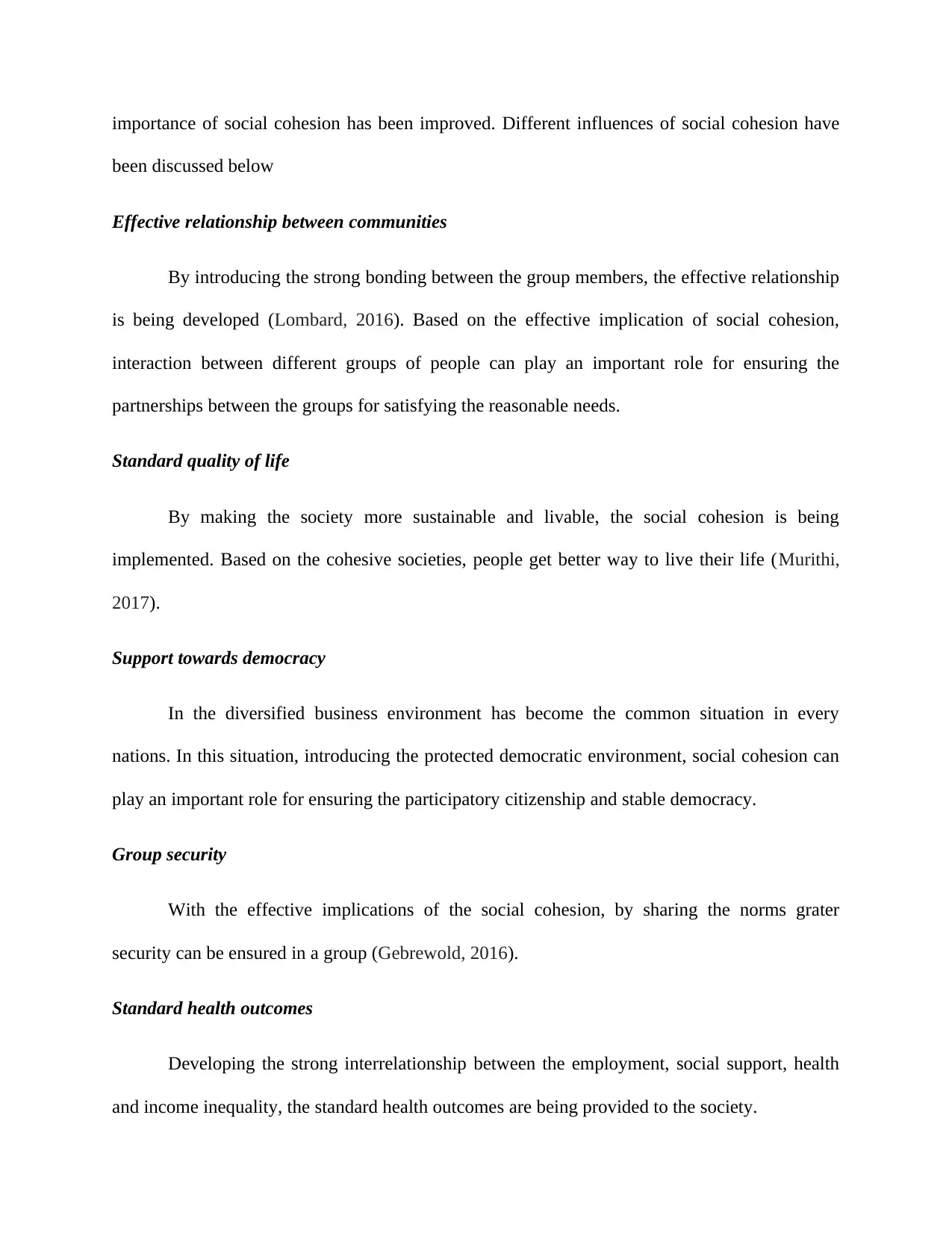
importance of social cohesion has been improved. Different influences of social cohesion have
been discussed below
Effective relationship between communities
By introducing the strong bonding between the group members, the effective relationship
is being developed (Lombard, 2016). Based on the effective implication of social cohesion,
interaction between different groups of people can play an important role for ensuring the
partnerships between the groups for satisfying the reasonable needs.
Standard quality of life
By making the society more sustainable and livable, the social cohesion is being
implemented. Based on the cohesive societies, people get better way to live their life (Murithi,
2017).
Support towards democracy
In the diversified business environment has become the common situation in every
nations. In this situation, introducing the protected democratic environment, social cohesion can
play an important role for ensuring the participatory citizenship and stable democracy.
Group security
With the effective implications of the social cohesion, by sharing the norms grater
security can be ensured in a group (Gebrewold, 2016).
Standard health outcomes
Developing the strong interrelationship between the employment, social support, health
and income inequality, the standard health outcomes are being provided to the society.
been discussed below
Effective relationship between communities
By introducing the strong bonding between the group members, the effective relationship
is being developed (Lombard, 2016). Based on the effective implication of social cohesion,
interaction between different groups of people can play an important role for ensuring the
partnerships between the groups for satisfying the reasonable needs.
Standard quality of life
By making the society more sustainable and livable, the social cohesion is being
implemented. Based on the cohesive societies, people get better way to live their life (Murithi,
2017).
Support towards democracy
In the diversified business environment has become the common situation in every
nations. In this situation, introducing the protected democratic environment, social cohesion can
play an important role for ensuring the participatory citizenship and stable democracy.
Group security
With the effective implications of the social cohesion, by sharing the norms grater
security can be ensured in a group (Gebrewold, 2016).
Standard health outcomes
Developing the strong interrelationship between the employment, social support, health
and income inequality, the standard health outcomes are being provided to the society.
Paraphrase This Document
Need a fresh take? Get an instant paraphrase of this document with our AI Paraphraser
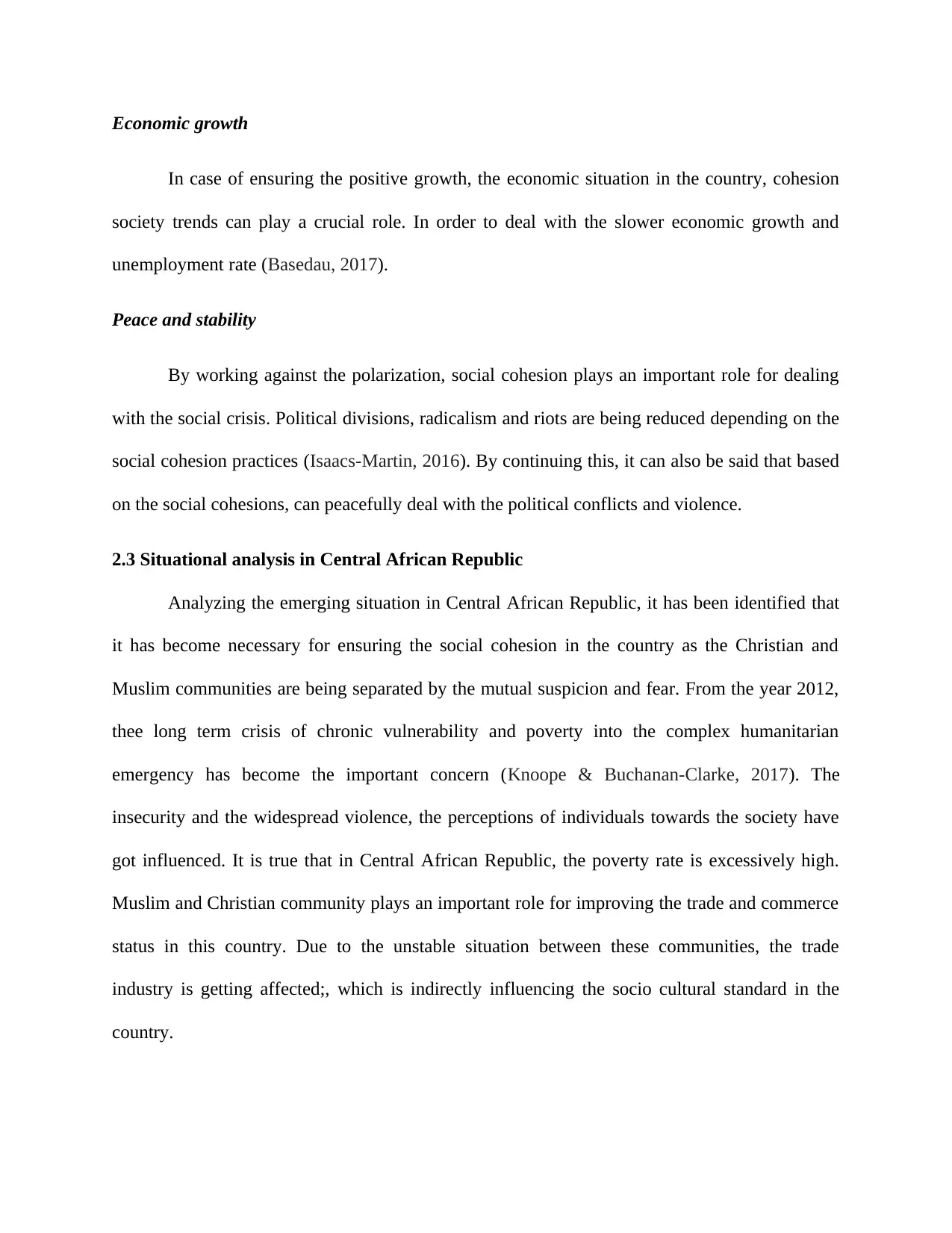
Economic growth
In case of ensuring the positive growth, the economic situation in the country, cohesion
society trends can play a crucial role. In order to deal with the slower economic growth and
unemployment rate (Basedau, 2017).
Peace and stability
By working against the polarization, social cohesion plays an important role for dealing
with the social crisis. Political divisions, radicalism and riots are being reduced depending on the
social cohesion practices (Isaacs-Martin, 2016). By continuing this, it can also be said that based
on the social cohesions, can peacefully deal with the political conflicts and violence.
2.3 Situational analysis in Central African Republic
Analyzing the emerging situation in Central African Republic, it has been identified that
it has become necessary for ensuring the social cohesion in the country as the Christian and
Muslim communities are being separated by the mutual suspicion and fear. From the year 2012,
thee long term crisis of chronic vulnerability and poverty into the complex humanitarian
emergency has become the important concern (Knoope & Buchanan-Clarke, 2017). The
insecurity and the widespread violence, the perceptions of individuals towards the society have
got influenced. It is true that in Central African Republic, the poverty rate is excessively high.
Muslim and Christian community plays an important role for improving the trade and commerce
status in this country. Due to the unstable situation between these communities, the trade
industry is getting affected;, which is indirectly influencing the socio cultural standard in the
country.
In case of ensuring the positive growth, the economic situation in the country, cohesion
society trends can play a crucial role. In order to deal with the slower economic growth and
unemployment rate (Basedau, 2017).
Peace and stability
By working against the polarization, social cohesion plays an important role for dealing
with the social crisis. Political divisions, radicalism and riots are being reduced depending on the
social cohesion practices (Isaacs-Martin, 2016). By continuing this, it can also be said that based
on the social cohesions, can peacefully deal with the political conflicts and violence.
2.3 Situational analysis in Central African Republic
Analyzing the emerging situation in Central African Republic, it has been identified that
it has become necessary for ensuring the social cohesion in the country as the Christian and
Muslim communities are being separated by the mutual suspicion and fear. From the year 2012,
thee long term crisis of chronic vulnerability and poverty into the complex humanitarian
emergency has become the important concern (Knoope & Buchanan-Clarke, 2017). The
insecurity and the widespread violence, the perceptions of individuals towards the society have
got influenced. It is true that in Central African Republic, the poverty rate is excessively high.
Muslim and Christian community plays an important role for improving the trade and commerce
status in this country. Due to the unstable situation between these communities, the trade
industry is getting affected;, which is indirectly influencing the socio cultural standard in the
country.
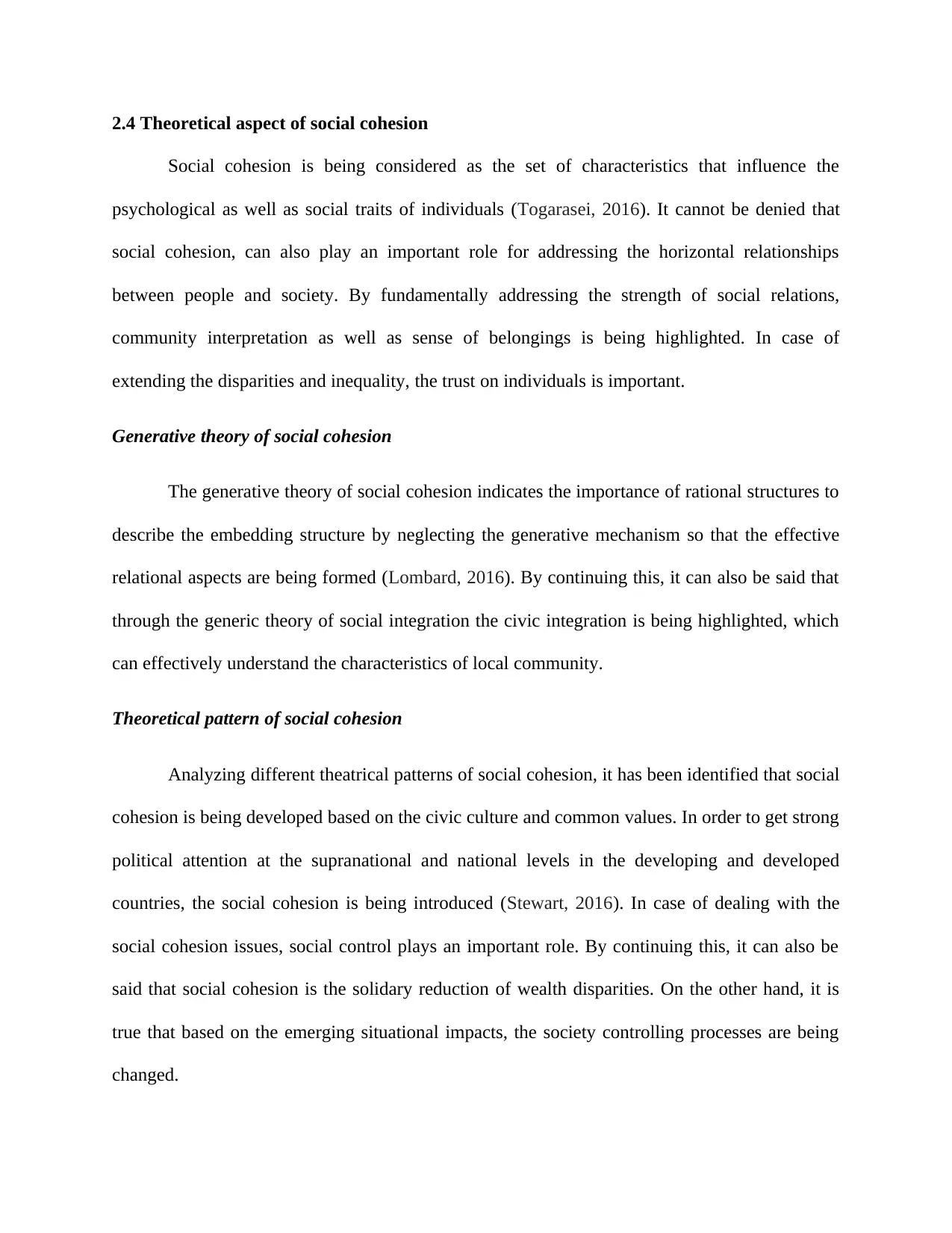
2.4 Theoretical aspect of social cohesion
Social cohesion is being considered as the set of characteristics that influence the
psychological as well as social traits of individuals (Togarasei, 2016). It cannot be denied that
social cohesion, can also play an important role for addressing the horizontal relationships
between people and society. By fundamentally addressing the strength of social relations,
community interpretation as well as sense of belongings is being highlighted. In case of
extending the disparities and inequality, the trust on individuals is important.
Generative theory of social cohesion
The generative theory of social cohesion indicates the importance of rational structures to
describe the embedding structure by neglecting the generative mechanism so that the effective
relational aspects are being formed (Lombard, 2016). By continuing this, it can also be said that
through the generic theory of social integration the civic integration is being highlighted, which
can effectively understand the characteristics of local community.
Theoretical pattern of social cohesion
Analyzing different theatrical patterns of social cohesion, it has been identified that social
cohesion is being developed based on the civic culture and common values. In order to get strong
political attention at the supranational and national levels in the developing and developed
countries, the social cohesion is being introduced (Stewart, 2016). In case of dealing with the
social cohesion issues, social control plays an important role. By continuing this, it can also be
said that social cohesion is the solidary reduction of wealth disparities. On the other hand, it is
true that based on the emerging situational impacts, the society controlling processes are being
changed.
Social cohesion is being considered as the set of characteristics that influence the
psychological as well as social traits of individuals (Togarasei, 2016). It cannot be denied that
social cohesion, can also play an important role for addressing the horizontal relationships
between people and society. By fundamentally addressing the strength of social relations,
community interpretation as well as sense of belongings is being highlighted. In case of
extending the disparities and inequality, the trust on individuals is important.
Generative theory of social cohesion
The generative theory of social cohesion indicates the importance of rational structures to
describe the embedding structure by neglecting the generative mechanism so that the effective
relational aspects are being formed (Lombard, 2016). By continuing this, it can also be said that
through the generic theory of social integration the civic integration is being highlighted, which
can effectively understand the characteristics of local community.
Theoretical pattern of social cohesion
Analyzing different theatrical patterns of social cohesion, it has been identified that social
cohesion is being developed based on the civic culture and common values. In order to get strong
political attention at the supranational and national levels in the developing and developed
countries, the social cohesion is being introduced (Stewart, 2016). In case of dealing with the
social cohesion issues, social control plays an important role. By continuing this, it can also be
said that social cohesion is the solidary reduction of wealth disparities. On the other hand, it is
true that based on the emerging situational impacts, the society controlling processes are being
changed.
⊘ This is a preview!⊘
Do you want full access?
Subscribe today to unlock all pages.

Trusted by 1+ million students worldwide
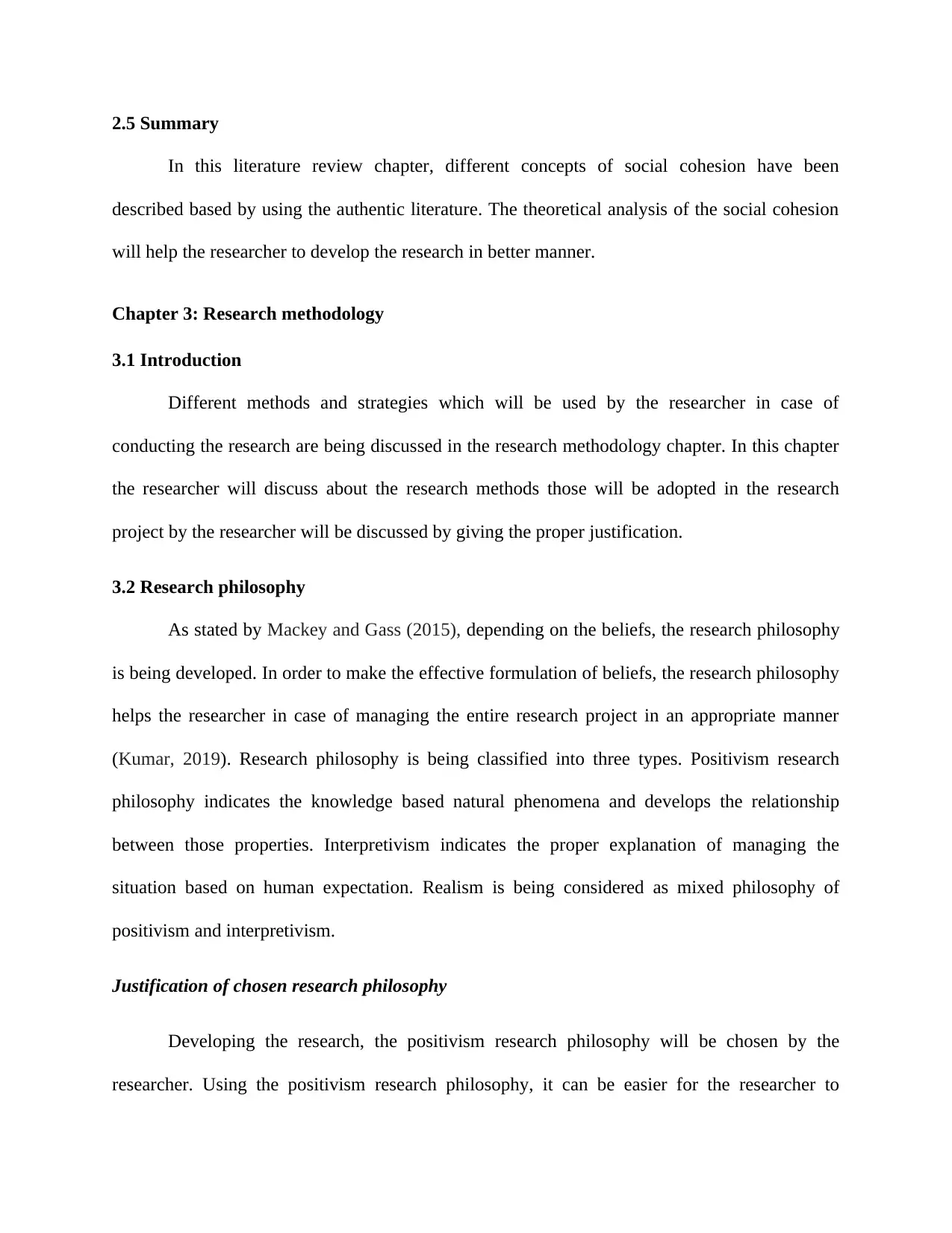
2.5 Summary
In this literature review chapter, different concepts of social cohesion have been
described based by using the authentic literature. The theoretical analysis of the social cohesion
will help the researcher to develop the research in better manner.
Chapter 3: Research methodology
3.1 Introduction
Different methods and strategies which will be used by the researcher in case of
conducting the research are being discussed in the research methodology chapter. In this chapter
the researcher will discuss about the research methods those will be adopted in the research
project by the researcher will be discussed by giving the proper justification.
3.2 Research philosophy
As stated by Mackey and Gass (2015), depending on the beliefs, the research philosophy
is being developed. In order to make the effective formulation of beliefs, the research philosophy
helps the researcher in case of managing the entire research project in an appropriate manner
(Kumar, 2019). Research philosophy is being classified into three types. Positivism research
philosophy indicates the knowledge based natural phenomena and develops the relationship
between those properties. Interpretivism indicates the proper explanation of managing the
situation based on human expectation. Realism is being considered as mixed philosophy of
positivism and interpretivism.
Justification of chosen research philosophy
Developing the research, the positivism research philosophy will be chosen by the
researcher. Using the positivism research philosophy, it can be easier for the researcher to
In this literature review chapter, different concepts of social cohesion have been
described based by using the authentic literature. The theoretical analysis of the social cohesion
will help the researcher to develop the research in better manner.
Chapter 3: Research methodology
3.1 Introduction
Different methods and strategies which will be used by the researcher in case of
conducting the research are being discussed in the research methodology chapter. In this chapter
the researcher will discuss about the research methods those will be adopted in the research
project by the researcher will be discussed by giving the proper justification.
3.2 Research philosophy
As stated by Mackey and Gass (2015), depending on the beliefs, the research philosophy
is being developed. In order to make the effective formulation of beliefs, the research philosophy
helps the researcher in case of managing the entire research project in an appropriate manner
(Kumar, 2019). Research philosophy is being classified into three types. Positivism research
philosophy indicates the knowledge based natural phenomena and develops the relationship
between those properties. Interpretivism indicates the proper explanation of managing the
situation based on human expectation. Realism is being considered as mixed philosophy of
positivism and interpretivism.
Justification of chosen research philosophy
Developing the research, the positivism research philosophy will be chosen by the
researcher. Using the positivism research philosophy, it can be easier for the researcher to
Paraphrase This Document
Need a fresh take? Get an instant paraphrase of this document with our AI Paraphraser
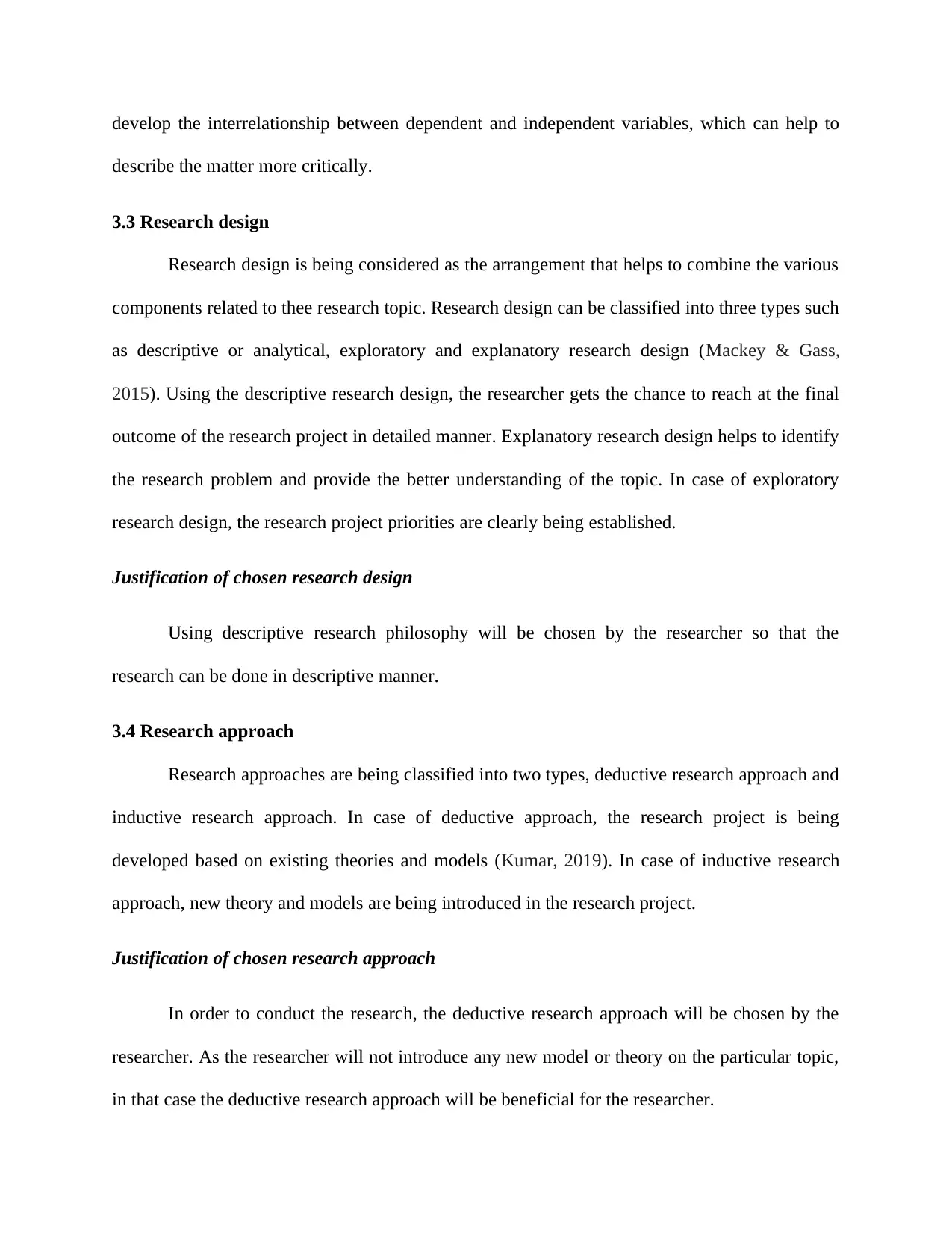
develop the interrelationship between dependent and independent variables, which can help to
describe the matter more critically.
3.3 Research design
Research design is being considered as the arrangement that helps to combine the various
components related to thee research topic. Research design can be classified into three types such
as descriptive or analytical, exploratory and explanatory research design (Mackey & Gass,
2015). Using the descriptive research design, the researcher gets the chance to reach at the final
outcome of the research project in detailed manner. Explanatory research design helps to identify
the research problem and provide the better understanding of the topic. In case of exploratory
research design, the research project priorities are clearly being established.
Justification of chosen research design
Using descriptive research philosophy will be chosen by the researcher so that the
research can be done in descriptive manner.
3.4 Research approach
Research approaches are being classified into two types, deductive research approach and
inductive research approach. In case of deductive approach, the research project is being
developed based on existing theories and models (Kumar, 2019). In case of inductive research
approach, new theory and models are being introduced in the research project.
Justification of chosen research approach
In order to conduct the research, the deductive research approach will be chosen by the
researcher. As the researcher will not introduce any new model or theory on the particular topic,
in that case the deductive research approach will be beneficial for the researcher.
describe the matter more critically.
3.3 Research design
Research design is being considered as the arrangement that helps to combine the various
components related to thee research topic. Research design can be classified into three types such
as descriptive or analytical, exploratory and explanatory research design (Mackey & Gass,
2015). Using the descriptive research design, the researcher gets the chance to reach at the final
outcome of the research project in detailed manner. Explanatory research design helps to identify
the research problem and provide the better understanding of the topic. In case of exploratory
research design, the research project priorities are clearly being established.
Justification of chosen research design
Using descriptive research philosophy will be chosen by the researcher so that the
research can be done in descriptive manner.
3.4 Research approach
Research approaches are being classified into two types, deductive research approach and
inductive research approach. In case of deductive approach, the research project is being
developed based on existing theories and models (Kumar, 2019). In case of inductive research
approach, new theory and models are being introduced in the research project.
Justification of chosen research approach
In order to conduct the research, the deductive research approach will be chosen by the
researcher. As the researcher will not introduce any new model or theory on the particular topic,
in that case the deductive research approach will be beneficial for the researcher.
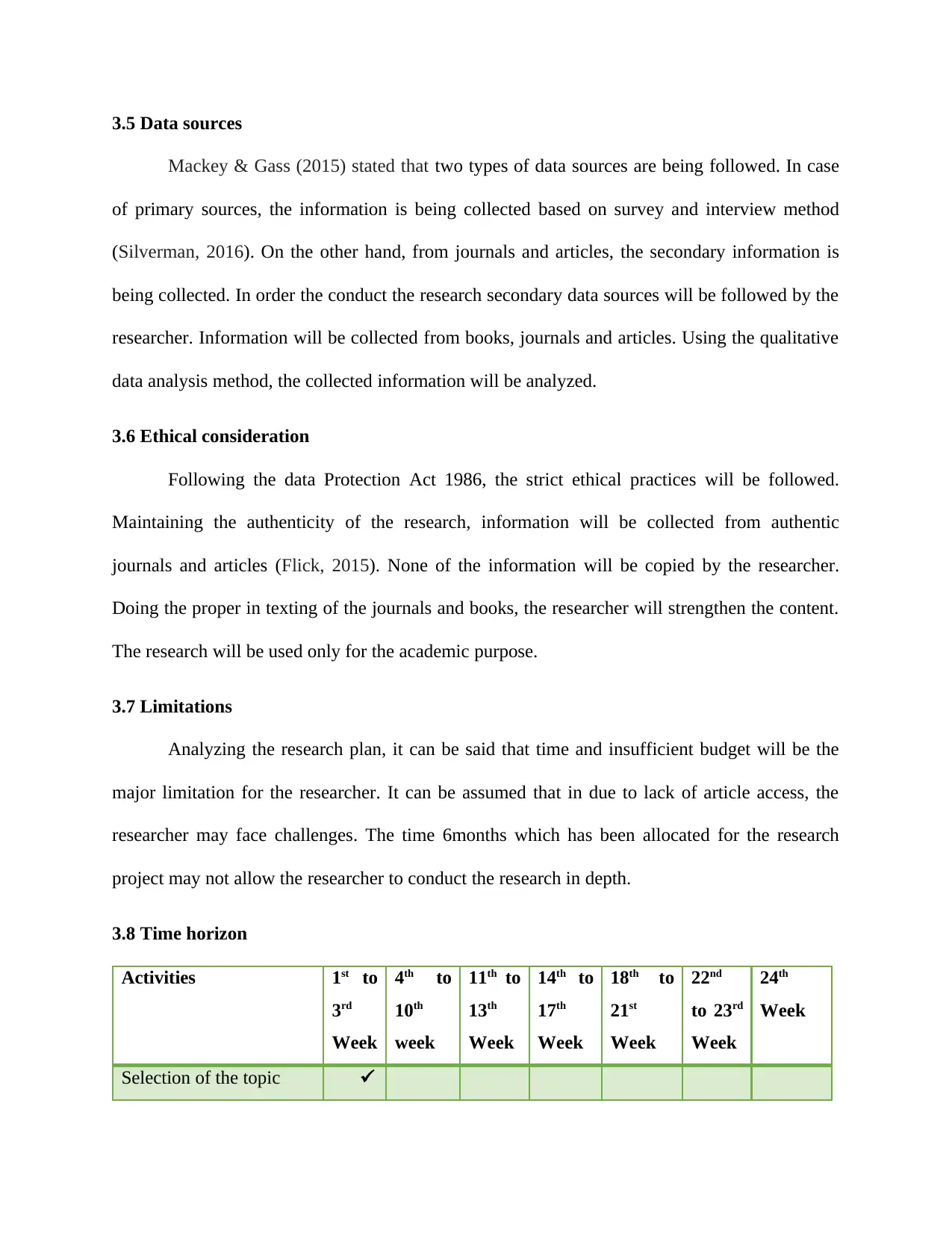
3.5 Data sources
Mackey & Gass (2015) stated that two types of data sources are being followed. In case
of primary sources, the information is being collected based on survey and interview method
(Silverman, 2016). On the other hand, from journals and articles, the secondary information is
being collected. In order the conduct the research secondary data sources will be followed by the
researcher. Information will be collected from books, journals and articles. Using the qualitative
data analysis method, the collected information will be analyzed.
3.6 Ethical consideration
Following the data Protection Act 1986, the strict ethical practices will be followed.
Maintaining the authenticity of the research, information will be collected from authentic
journals and articles (Flick, 2015). None of the information will be copied by the researcher.
Doing the proper in texting of the journals and books, the researcher will strengthen the content.
The research will be used only for the academic purpose.
3.7 Limitations
Analyzing the research plan, it can be said that time and insufficient budget will be the
major limitation for the researcher. It can be assumed that in due to lack of article access, the
researcher may face challenges. The time 6months which has been allocated for the research
project may not allow the researcher to conduct the research in depth.
3.8 Time horizon
Activities 1st to
3rd
Week
4th to
10th
week
11th to
13th
Week
14th to
17th
Week
18th to
21st
Week
22nd
to 23rd
Week
24th
Week
Selection of the topic
Mackey & Gass (2015) stated that two types of data sources are being followed. In case
of primary sources, the information is being collected based on survey and interview method
(Silverman, 2016). On the other hand, from journals and articles, the secondary information is
being collected. In order the conduct the research secondary data sources will be followed by the
researcher. Information will be collected from books, journals and articles. Using the qualitative
data analysis method, the collected information will be analyzed.
3.6 Ethical consideration
Following the data Protection Act 1986, the strict ethical practices will be followed.
Maintaining the authenticity of the research, information will be collected from authentic
journals and articles (Flick, 2015). None of the information will be copied by the researcher.
Doing the proper in texting of the journals and books, the researcher will strengthen the content.
The research will be used only for the academic purpose.
3.7 Limitations
Analyzing the research plan, it can be said that time and insufficient budget will be the
major limitation for the researcher. It can be assumed that in due to lack of article access, the
researcher may face challenges. The time 6months which has been allocated for the research
project may not allow the researcher to conduct the research in depth.
3.8 Time horizon
Activities 1st to
3rd
Week
4th to
10th
week
11th to
13th
Week
14th to
17th
Week
18th to
21st
Week
22nd
to 23rd
Week
24th
Week
Selection of the topic
⊘ This is a preview!⊘
Do you want full access?
Subscribe today to unlock all pages.

Trusted by 1+ million students worldwide
1 out of 16
Related Documents
Your All-in-One AI-Powered Toolkit for Academic Success.
+13062052269
info@desklib.com
Available 24*7 on WhatsApp / Email
![[object Object]](/_next/static/media/star-bottom.7253800d.svg)
Unlock your academic potential
Copyright © 2020–2025 A2Z Services. All Rights Reserved. Developed and managed by ZUCOL.





